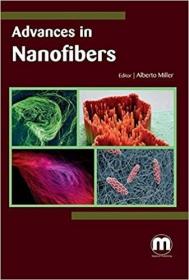
现货Advances in Nanofibers[9781682500057]
¥ 1518 九五品
仅1件
上海宝山
认证卖家担保交易快速发货售后保障
作者Alberto Miller
出版社Magnum Publishing LLC
ISBN9781682500057
出版时间2016-01
装帧精装
纸张其他
正文语种英语
上书时间2023-08-08
- 最新上架
商品详情
- 品相描述:九五品
- 商品描述
-
Nanofibers are fibers measured in nanometers. The size of nanofibers is just a 3-4 atoms thick with diameters of 50–500nm. They can be produced by interfacial polymerization and electrospinning. Carbon nanofibers are graphitized fibers produced by catalytic synthesis. Nanofibers have applications in medicine, including artificial organ components, tissue engineering, implant material, drug delivery, wound dressing, and medical textile materials. The text Advances in Nanofibers focuses on nanofiber technology and its application.
The structural and morphological characterization of micro and nanofibers has been discussed inn first chapter. The purpose of second chapter is to confirm the enhancement of nanofibers or nanotubes’ reinforcement on the mechanical performances of dental restorative composite. In third chapter, we discuss templateless synthesis and characterization of hollow gadolinium doped cerium oxide nanofibers. The design and characterization of electrospun polyamide nanofiber media for air filtration applications has been proposed in fourth chapter. Fifth chapter describes the preparation method for gold nanoparticles loaded chitin nanofiber composite. Sixth chapter focuses on recent trends in electrospinning using various polymeric materials. The purpose of seventh chapter is to review cellulose nanofibers (CNFs) which are applied in optoelectronic conversion and energy storage. Eighth chapter focuses on the advanced applications of EHD techniques for incorporation of therapeutic agents into the polymeric carriers in order to develop novel drug-delivery systems. The aim of ninth chapter is to investigate a new synthetic graft copolymer as a hydrophilic carrier polymer in electrospinning of nanofibrous drug delivery systems (DDSs). The fundamentals of electrospinning of nanofibers and their applications for energy devices have been presented tenth chapter. In eleventh chapter, we deal with the fabrication and evaluation of polycaprolactone/gelatin-based electrospun nanofibers with antibacterial properties. The eluotropic capacities of methanol, acetonitrile and water have been studied in twelfth chapter. Thirteenth chapter discuss how to improve methane sensing properties of co-doped SNO2 electrospun nanofibers. The enhancement of ultrahigh performance concrete material properties with carbon nanofiber has been focused in fourteenth chapter. The objective of fifteenth chapter is to examine the effect of the precursor silica source on the morphology and nature of the silicon nitride nanofibers. In sixteenth chapter, we deal with the hydrogen sorption in graphite nanofibers. The preparation, characterization and biological response of electrospun nanofibers have been discussed in seventeenth chapter. Eighteenth chapter deals with gelatin nanofibres functionalized with silver nanoparticles, prepared by electrospinning using solutions of gelatin mixed with silver nitrate (AgNO3). Applications and of chitin nanofibers has been introduced in nineteenth chapter. The fabrication of nanofibrous scaffolds by electrospinning has been proposed in twentieth chapter. Last chapter focuses on manufacturing techniques and material combination for the fabrication of the nanostructured reinforced polymers.
— 没有更多了 —
![现货Advances in Nanofibers[9781682500057]](https://www0.kfzimg.com/sw/kfz-cos/kfzimg/17733071/ff85756cbced38af_b.jpg)

![现货Materials and Technologies of Modern Production[9783036401683]](https://www0.kfzimg.com/sw/kfz-cos/kfzimg/17733071/5fd2824531e165d7_s.jpg)
![现货Introduction to Container Ship Operations and Onboard Safety[9781032155425]](https://www0.kfzimg.com/sw/kfz-cos/kfzimg/17733071/58b7ff43ef7909ee_s.jpg)
![现货Electrophosphorescent Materials and Devices[9789814877343]](https://www0.kfzimg.com/sw/kfz-cos/kfzimg/17733071/18cc1d77bcb7b488_s.jpg)
![现货Organic Semiconductors for Optoelectronics[9781119146100]](https://www0.kfzimg.com/sw/kfz-cos/kfzimg/17733071/24c85a750c708964_s.jpg)
![现货Advances in Food Rheology and Its Applications[9780081004319]](https://www0.kfzimg.com/sw/kfz-cos/kfzimg/17733071/e0c11603c9119d4d_s.jpg)
![现货Advanced Materials and Sustainable Technologies[9783035727562]](https://www0.kfzimg.com/sw/kfz-cos/kfzimg/17733071/dced675333874c48_s.jpg)
![现货Advanced Materials and Manufacturing Engineering II[9783035712681]](https://www0.kfzimg.com/sw/kfz-cos/kfzimg/17733071/660ccfae75fa8d3e_s.jpg)
![现货Materials in Machinery and Construction[9783035718119]](https://www0.kfzimg.com/sw/kfz-cos/kfzimg/17733071/6f402060775e9daa_s.jpg)
![现货Cereal Grain Quality (Softcover Reprint of the Original 1st 1996)[9789401071772]](https://www0.kfzimg.com/sw/kfz-cos/kfzimg/17733071/f93ca1c96a97403a_s.jpg)
![现货Advances in Nanofibers[9781682500057]](/dist/img/error.jpg)
以下为对购买帮助不大的评价